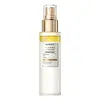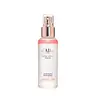What's inside
What's inside
 Key Ingredients
Key Ingredients

 Benefits
Benefits

 Concerns
Concerns

 Ingredients Side-by-side
Ingredients Side-by-side

Bifida Ferment Filtrate
Skin ConditioningLactobacillus Ferment
Skin ConditioningIsododecane
EmollientButylene Glycol
HumectantDiphenylsiloxy Phenyl Trimethicone
Skin ConditioningGlycerin
HumectantSqualane
EmollientPEG/PPG/Polybutylene Glycol-8/5/3 Glycerin
HumectantNiacinamide
SmoothingCentella Asiatica Leaf Extract
Skin ConditioningOlea Europaea Leaf Extract
PerfumingPolyglycerin-10
HumectantWater
Skin Conditioning1,2-Hexanediol
Skin ConditioningThermus Thermophillus Ferment
Skin ConditioningEctoin
Skin ConditioningPanthenol
Skin ConditioningHydroxyacetophenone
AntioxidantSodium Chloride
MaskingSodium Hyaluronate
HumectantHippophae Rhamnoides Fruit Oil
Skin ProtectingAroma
Hexylene Glycol
EmulsifyingSaccharide Isomerate
HumectantCaprylhydroxamic Acid
Citric Acid
BufferingSodium Citrate
BufferingBifida Ferment Filtrate, Lactobacillus Ferment, Isododecane, Butylene Glycol, Diphenylsiloxy Phenyl Trimethicone, Glycerin, Squalane, PEG/PPG/Polybutylene Glycol-8/5/3 Glycerin, Niacinamide, Centella Asiatica Leaf Extract, Olea Europaea Leaf Extract, Polyglycerin-10, Water, 1,2-Hexanediol, Thermus Thermophillus Ferment, Ectoin, Panthenol, Hydroxyacetophenone, Sodium Chloride, Sodium Hyaluronate, Hippophae Rhamnoides Fruit Oil, Aroma, Hexylene Glycol, Saccharide Isomerate, Caprylhydroxamic Acid, Citric Acid, Sodium Citrate
Water
Skin ConditioningIsododecane
Emollient1,2-Hexanediol
Skin ConditioningDipropylene Glycol
HumectantGlycereth-26
HumectantTuber Magnatum Extract
Skin ConditioningButylene Glycol
HumectantPolypropylsilsesquioxane
Hydroxyethyl Urea
HumectantLithospermum Erythrorhizon Root Extract
Skin ConditioningMacadamia Ternifolia Seed Oil
EmollientBetaine
HumectantPersea Gratissima Oil
Skin ConditioningRosa Canina Fruit Oil
EmollientCaprylic/Capric Triglyceride
MaskingPunica Granatum Fruit Extract
AntioxidantGlyceryl Glucoside
HumectantDipotassium Glycyrrhizate
HumectantDisodium EDTA
Tocopherol
AntioxidantAdenosine
Skin ConditioningSaccharide Isomerate
HumectantGlycerin
HumectantPelargonium Graveolens Flower Oil
MaskingPentaerythrityl Tetra-Di-T-Butyl Hydroxyhydrocinnamate
AntioxidantEclipta Prostrata Extract
Skin ConditioningXylitylglucoside
HumectantAcrylates/C10-30 Alkyl Acrylate Crosspolymer
Emulsion StabilisingArginine
MaskingAnhydroxylitol
HumectantArtemisia Annua Extract
MaskingNelumbo Nucifera Flower Extract
Skin ConditioningOryza Sativa Extract
AbsorbentSaccharomyces Ferment
Skin ConditioningXylitol
HumectantMelia Azadirachta Leaf Extract
Skin ConditioningLavandula Angustifolia Flower Extract
CleansingAnthemis Nobilis Flower Extract
MaskingCamellia Sinensis Leaf Extract
AntimicrobialEucalyptus Globulus Leaf Extract
PerfumingHibiscus Sabdariffa Flower Extract
Skin ConditioningMelilotus Officinalis Extract
AstringentOlea Europaea Leaf Extract
PerfumingRosmarinus Officinalis Leaf Extract
AntimicrobialCalendula Officinalis Flower Extract
MaskingCymbopogon Citratus Extract
Skin ConditioningJasminum Officinale Extract
MaskingMentha Rotundifolia Leaf Extract
TonicSalvia Officinalis Extract
AntimicrobialMelaleuca Alternifolia Leaf Extract
PerfumingMentha Piperita Leaf Extract
Skin ConditioningCitric Acid
BufferingSodium Citrate
BufferingGlucose
HumectantRose Flower Oil
MaskingMoringa Oleifera Seed Oil
EmollientPrunus Serrulata Flower Extract
Skin ConditioningSodium Hyaluronate
HumectantOriganum Vulgare Extract
Skin ConditioningThymus Vulgaris Flower/Leaf/Stem Extract
Skin ConditioningHydroxypropyltrimonium Hyaluronate
Hydrolyzed Hyaluronic Acid
HumectantSodium Acetylated Hyaluronate
HumectantHyaluronic Acid
HumectantHydrolyzed Sodium Hyaluronate
Skin ConditioningSodium Hyaluronate Crosspolymer
HumectantPotassium Hyaluronate
Skin ConditioningParfum
MaskingButylphenyl Methylpropional
PerfumingLinalool
PerfumingHexyl Cinnamal
PerfumingLimonene
PerfumingCitronellol
PerfumingGeraniol
PerfumingWater, Isododecane, 1,2-Hexanediol, Dipropylene Glycol, Glycereth-26, Tuber Magnatum Extract, Butylene Glycol, Polypropylsilsesquioxane, Hydroxyethyl Urea, Lithospermum Erythrorhizon Root Extract, Macadamia Ternifolia Seed Oil, Betaine, Persea Gratissima Oil, Rosa Canina Fruit Oil, Caprylic/Capric Triglyceride, Punica Granatum Fruit Extract, Glyceryl Glucoside, Dipotassium Glycyrrhizate, Disodium EDTA, Tocopherol, Adenosine, Saccharide Isomerate, Glycerin, Pelargonium Graveolens Flower Oil, Pentaerythrityl Tetra-Di-T-Butyl Hydroxyhydrocinnamate, Eclipta Prostrata Extract, Xylitylglucoside, Acrylates/C10-30 Alkyl Acrylate Crosspolymer, Arginine, Anhydroxylitol, Artemisia Annua Extract, Nelumbo Nucifera Flower Extract, Oryza Sativa Extract, Saccharomyces Ferment, Xylitol, Melia Azadirachta Leaf Extract, Lavandula Angustifolia Flower Extract, Anthemis Nobilis Flower Extract, Camellia Sinensis Leaf Extract, Eucalyptus Globulus Leaf Extract, Hibiscus Sabdariffa Flower Extract, Melilotus Officinalis Extract, Olea Europaea Leaf Extract, Rosmarinus Officinalis Leaf Extract, Calendula Officinalis Flower Extract, Cymbopogon Citratus Extract, Jasminum Officinale Extract, Mentha Rotundifolia Leaf Extract, Salvia Officinalis Extract, Melaleuca Alternifolia Leaf Extract, Mentha Piperita Leaf Extract, Citric Acid, Sodium Citrate, Glucose, Rose Flower Oil, Moringa Oleifera Seed Oil, Prunus Serrulata Flower Extract, Sodium Hyaluronate, Origanum Vulgare Extract, Thymus Vulgaris Flower/Leaf/Stem Extract, Hydroxypropyltrimonium Hyaluronate, Hydrolyzed Hyaluronic Acid, Sodium Acetylated Hyaluronate, Hyaluronic Acid, Hydrolyzed Sodium Hyaluronate, Sodium Hyaluronate Crosspolymer, Potassium Hyaluronate, Parfum, Butylphenyl Methylpropional, Linalool, Hexyl Cinnamal, Limonene, Citronellol, Geraniol
 Reviews
Reviews

Ingredients Explained
These ingredients are found in both products.
Ingredients higher up in an ingredient list are typically present in a larger amount.
1,2-Hexanediol is a synthetic liquid and another multi-functional powerhouse.
It is a:
- Humectant, drawing moisture into the skin
- Emollient, helping to soften skin
- Solvent, dispersing and stabilizing formulas
- Preservative booster, enhancing the antimicrobial activity of other preservatives
Butylene Glycol (or BG) is used within cosmetic products for a few different reasons:
Overall, Butylene Glycol is a safe and well-rounded ingredient that works well with other ingredients.
Though this ingredient works well with most skin types, some people with sensitive skin may experience a reaction such as allergic rashes, closed comedones, or itchiness.
Learn more about Butylene GlycolCitric Acid is an alpha hydroxy acid (AHA) naturally found in citrus fruits like oranges, lemons, and limes.
Like other AHAs, citric acid can exfoliate skin by breaking down the bonds that hold dead skin cells together. This helps reveal smoother and brighter skin underneath.
However, this exfoliating effect only happens at high concentrations (20%) which can be hard to find in cosmetic products.
Due to this, citric acid is usually included in small amounts as a pH adjuster. This helps keep products slightly more acidic and compatible with skin's natural pH.
In skincare formulas, citric acid can:
While it can provide some skin benefits, research shows lactic acid and glycolic acid are generally more effective and less irritating exfoliants.
Most citric acid used in skincare today is made by fermenting sugars (usually from molasses). This synthetic version is identical to the natural citrus form but easier to stabilize and use in formulations.
Read more about some other popular AHA's here:
Learn more about Citric AcidGlycerin is already naturally found in your skin. It helps moisturize and protect your skin.
A study from 2016 found glycerin to be more effective as a humectant than AHAs and hyaluronic acid.
As a humectant, it helps the skin stay hydrated by pulling moisture to your skin. The low molecular weight of glycerin allows it to pull moisture into the deeper layers of your skin.
Hydrated skin improves your skin barrier; Your skin barrier helps protect against irritants and bacteria.
Glycerin has also been found to have antimicrobial and antiviral properties. Due to these properties, glycerin is often used in wound and burn treatments.
In cosmetics, glycerin is usually derived from plants such as soybean or palm. However, it can also be sourced from animals, such as tallow or animal fat.
This ingredient is organic, colorless, odorless, and non-toxic.
Glycerin is the name for this ingredient in American English. British English uses Glycerol/Glycerine.
Learn more about GlycerinIsododecane is a fragrance, emollient, and solvent.
As an emollient, it helps your skin stay soft and hydrated. Emollients help trap moisture into your skin.
Isododecane's role as a solvent makes it a great texture enhancer. It spreads smoothly on skin and does not leave a sticky feeling behind. Isododecane also helps prevent color transfer in makeup products.
Isododecane is not absorbed into skin.
Learn more about IsododecaneOlive tree leaves contain more antioxidants than olive fruit.
This is due to its rich flavonoid and polyphenol content. However, the antioxidant content varies depending on plant variety, harvesting method, leaf maturity, and extraction method.
This ingredient also has a natural fragrance. Read more about fragrance in cosmetics here.
Learn more about Olea Europaea Leaf ExtractSaccharide Isomerate comes from sugars found in corn. It is a skin hydrator.
The structure of this ingredient can be altered to be more similar to the carbohydrates found in our skin. This ability to mimic our skin gives it hydrating properties.
Specifically, saccharide Isomerate is a humectant. Humectants draw moisture from the air to our skin.
Research shows Saccharide Isomerate to be an effective moisturizer.
Learn more about Saccharide IsomerateSodium Citrate is the sodium salts of citric acid. In skincare, it is used to alter pH levels and acts as a preservative.
Its main functions are to maintain the pH of a product and neutralize metal ions.
The acidity of our skin is maintained by our glands and skin biome; normal pH level of skin is slightly acidic (~4.75-5.5).
Being slightly acidic allows our skin to create an "acid mantle". This acid mantle is a thin barrier that protects our skin from bacteria and contaminants.
Learn more about Sodium CitrateSodium Hyaluronate is hyaluronic acid's salt form. It is commonly derived from the sodium salt of hyaluronic acid.
Like hyaluronic acid, it is great at holding water and acts as a humectant. This makes it a great skin hydrating ingredient.
Sodium Hyaluronate is naturally occurring in our bodies and is mostly found in eye fluid and joints.
These are some other common types of Hyaluronic Acid:
Learn more about Sodium HyaluronateWater. It's the most common cosmetic ingredient of all. You'll usually see it at the top of ingredient lists, meaning that it makes up the largest part of the product.
So why is it so popular? Water most often acts as a solvent - this means that it helps dissolve other ingredients into the formulation.
You'll also recognize water as that liquid we all need to stay alive. If you see this, drink a glass of water. Stay hydrated!
Learn more about Water